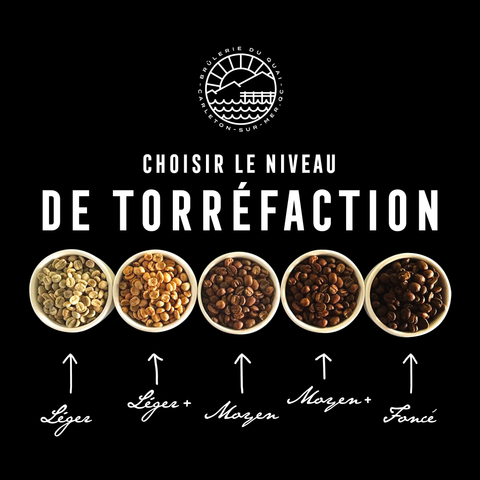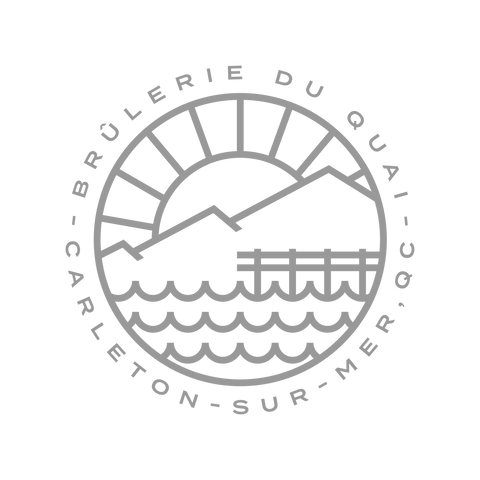
Once the green coffee arrives at our workshop, it will have already undergone several tasting tests, based on several roasting levels. Our primary goal is to analyze the coffee bean and see how its aromas develop with roasting.
Understanding roast levels and their effects on coffee

I invite you to look at the coffee flavor wheel .
On the right side of the wheel you can see a first circle “ flavors ” and a second circle composed of three sections “ Enzymes ” in yellow, “ Caramelized sugar ” in red and “ Dry distillation ” in purple. These three sections define the spectrum and orientation of the aromas depending on the roasting and which will express the terroir of the grain.
Here are the usual coffee roasting stages
As for roasting, the yellow “enzyme” section corresponds to the first stage of bean development at roasting, the 1st crack, at around 385°F on my roaster and which lasts approximately until 395°F.
Note that temperatures are slightly different from one roaster to another since the positioning of the probes and the techniques used on the equipment differ from one machine to another. However, the 1st crack is an indicator that does not lie.
Once well developed, the bean well caramelized, and once the bean has physically cracked in the roaster, we will be located in the yellow zone, or 400°F on my machine, approximately 30 seconds after hearing the first cracks.
And depending on the origin of the grain, we will then find aromas oriented towards the different subsections of the yellow zone. It is therefore the origin of the grain, its terroir, which will determine the aromas expressed by the level of roasting.
If we continue roasting, following the 1st crack, we then have a clearance of 15°F before the 2nd crack, a period of 50-60 seconds. It is therefore between 400°F and 415°F that the yellow and red zones of the “aromas” section of the flavor wheel are located. The more the temperature increases, the closer we get to the purple zone and the famous 2nd crack.
Without passing judgment, you can browse the aromas developed by extending the roasting to the 2nd crack and notice that the aromas described are not necessarily those you want to obtain in the cup.
How does the barista decide on the ideal roast level?
If we come back to green coffee, and I transfer the hat of master roaster to you, you then only have to choose the optimal roasting level, that is, the one that best expresses the terroir of the bean . With a good knowledge of how a coffee roaster works, it's relatively simple.
In my experience, selecting a roast level for a bean is complicated by the need to sell said coffee . And when the master roaster analyzes his customers, he must realize that he is faced with such a heterogeneous amalgam that confusion quickly sets in.
If I take Brûlerie du Quai as an example, I have several commercial clients working with La Marzocco at the cutting edge of techno coffee, residential clients with a GS3, others who use Jura full-auto coffee makers, Seaco manual, etc. For more manual preparations, it goes from the plunger, to the Clever, Chemex, to the Black'n Decker filter coffee maker at $15.
With a view to a direct purchase like the one we made with Rwanda, we find ourselves with several tons of coffee, several thousand dollars in inventory and we must satisfy our customers' palates. We must therefore sell the coffee, to make way for the new harvest and keep the business running.
The difficulty is to determine a level of roasting that will suit everyone , while expressing the terroir of the grain as much as possible. Mission impossible... Each preparation method influences the result of the cup, we then find ourselves with the left section of the flavor wheel and its entire spectrum of possibilities. Because if roasting slightly influences this section of the wheel, the preparation method has a lot to do with it.
So, each new coffee then suffers the wrath of the dissatisfied, not roasted enough, too roasted... but that will teach us to work with demanding customers ;-)

We must then determine who the coffee is aimed at.
To commercial or residential customers. Baristas need to know the intention behind the roast level or the selection of beans used in a blend before jumping to conclusions and saying this roaster is bad, that coffee is bad.
In the Brûlerie du Quai offering, we find a mixture called espresso crème special intended for residential espresso coffee makers. If I use this mixture in my La Marzocco, the result will be unpleasant but in a SeacoPoemia, it will be very pleasant.
Same thing with the Bella Espresso blend, intended for commercial and semi-pro coffee makers, this blend is delicious in a La Marzocco but with a SeacoPoemia customers will tell me that the coffee is not roasted enough... You follow me.
In the case of our arrival from Rwanda, we opted for a “city +” roast, i.e. 412°F. We are at 8° from the 2nd crack, the aromas being in the red zone of the flavor wheel, nuts, cocoa with a touch of lime in the background. This level of roasting allows for wider use in preparation, lending itself well to espresso and filter. It is therefore this level that you will find on the shelves of our points of sale, in 340g format. The choice was therefore based on flexibility in terms of preparation.
Beyond the size of the bag, it is possible, in collaboration with a customer, to roast the same coffee to their taste, depending on their preparation intentions. In V60, it would indeed be preferable to stay in the yellow section of the wheel with a roast closer to the 1st crack. We also have more and more customers who ask us for particular profiles, more or less roasted. We are a small family business, flexible and close to customers. It's always a pleasure to chat with customers with specific requests.
That briefly covers the implication of choosing a roast level. Please feel free to comment or ask questions.
Dany
Here are 5 coffees where you can really taste the difference between the types of roasts
- Lightweight: The Hawaiian Kona
- Light +: The Yemenia
- Medium: Brazil Cerrado
- Average +: The House Blend
- Dark: The Biological Zombie


Comments (4)
Bonjour,
Je vous remercie pour toutes ces informations .
Bonjour!
C’est vraiment généreux de partager ces informations!
Je torréfie mon café chez moi, à la poêle ou dans une plaque allant au four. J’aimerais savoir s’il est possible d’aller chercher le genre de spécificités qu’il y a sur la roulette de couleurs avec les méthodes de torréfaction que j’utilise?
Je vous remercie! =)
Bonjour;
Je voudrais vous remercie infiniment pour toutes ces informations ,et si possible pouvez vous m’aider avec des conseils et des démarches à faire pour un projet de torréfaction du café (surtout les techniques des mélanges pour l’espresso et le degré de torréfaction, merci beaucoup
Bonjour
Je suis à la recherche d’un poster des arômes du café, comme sur votre site.
Est-ce que vous pouvez m’aider ? Peut-être avez vous un fichier pour imprimer soi-même ?
D’avance merci pour votre aide.
Meilleures salutations
Yanick
Www.cafedumonde.ch